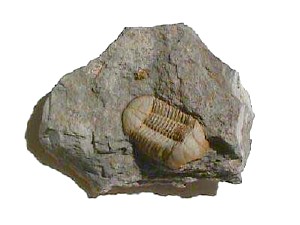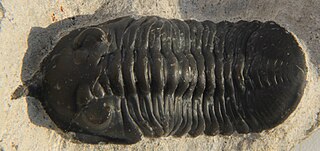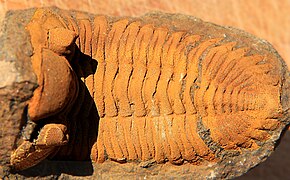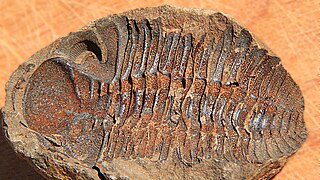
Phacops is a genus of trilobites in the order Phacopida, family Phacopidae, that lived in Europe, northwestern Africa, North and South America and China from the Late Ordovician until the very end of the Devonian, with a broader time range described from the Late Ordovician. It was a rounded animal, with a globose head and large eyes, and probably fed on detritus. Phacops is often found rolled up ("volvation"), a biological defense mechanism that is widespread among smaller trilobites but further perfected in this genus.

Ductina is a genus of extinct, small to average sized, eyeless phacopid trilobite, that lived during the Devonian.

Eldredgeops is a genus of trilobites in the order Phacopida, family Phacopidae, known from the late Middle and earliest Upper Devonian of Morocco and the USA.
Bainella is an extinct genus of Devonian trilobites from off the coast of Gondwana. Fossils were found in the Ponta Grossa Formation of Brazil, Belén, Icla and Gamoneda Formations of Bolivia and the Gydo, Gamka and Voorstehoek Formations of South Africa. It contains three species: B. africana, B. baini, and B. cristagalli.
Tarijactinoides is a genus of trilobites in the order Phacopida, which existed in what is now Bolivia. It was described by Suárez Soruco in 1971, and the type species is Tarijactinoides jarcasensis.
Calmonia is an extinct genus of trilobites. It contains one species: C. curvioculata. Fossils of Calmonia have been found in the Emsian to Eifelian Ponta Grossa Formation and Chapada Group of Brazil, the Belén and Sica Sica Formations of Bolivia and the Cordobés Formation of Uruguay.
Chacomurus is a genus of trilobites in the order Phacopida that existed during the lower Devonian in what is now Bolivia. It was described by Branisa and Vanek in 1973, and the type species is Chacomurus confragosus. It was described from the Belén Formation.
Chiarumanipyge is a genus of trilobites in the order Phacopida that existed during the lower Devonian in what is now Bolivia. It was described by Branisa and Vanek in 1973, and the type species is Chiarumanipyge profligata. It was described from the Belén Formation.
Cryphaeoides is a genus of trilobites in the order Phacopida, that existed during the lower Devonian in what is now Bolivia. It was described by Delo in 1935, and the type species is Cryphaeoides rostratus, which originally described under the genus Cryphaeus by Kozlowski in 1923. It was described from the Sicasica Formation in Patacamaya.
Fenestraspis is an extinct genus of trilobite in the order Phacopida from the Upper Pragian and Lower Emsian. Fenestraspis is unusual because of the development of extensive fenestrae in the posterior part of the body and apparently of the thorax, the presence of upwardly directed spines on the cephalon, thorax and pygidium, and the exceptionally large and highly elevated eyes.
Francovichia is a trilobite in the order Phacopida, that existed during the lower Devonian in what is now Bolivia. It was described by Branisa and Vanek in 1973, and the type species is Francovichia branisi, which was originally described under the genus Odontochile by Wolfart in 1968. It also contains the species, F. clarkei. The type locality was the Belén Formation.

Aayemenaytcheia paragranulata is a Middle Devonian proetid trilobite.

The buff-bellied fat-tailed mouse opossum is a species of opossum in the family Didelphidae. It is found in the transitional and humid forests of northern Argentina and southern Bolivia. Its dorsal fur is cinnamon brown. Most of its ventral fur is gray-based, but its chest, throat, and the thoracic midline are not gray-based. The postorbital ridges are absent in the young and weakly developed in adults.

Sica Sica is a small town and capital of Aroma Province in the La Paz Department of western Bolivia. It is located some 115 kilometres from La Paz, on the southwestern edge of the Serrania de Sicasica, a ridge, which is between La Paz and Cochabamba in a south-easterly direction. As of 2008 it has an estimated population of 4,620. The town is situated at a height of 3,933 metres on the Bolivian Altiplano. Nearby Sica Sica is Ayo Ayo, the birthplace of the indigenous rebel leader Julián Apaza.

Morocconites malladoides is an average size trilobite, which lived during the Devonian period, in what is now southern Morocco. This species is assumed to be a close relative of Acastoides. The most conspicuous feature is the very long upcurved frontal medial spine, a bit like an avocet bill. It is the only known species in this genus.

Viaphacops is a genus of trilobites in the order Phacopida, family Phacopidae, that lived during the Middle Devonian, and is known from North and South America, Asia.

The Cuche Formation is a geological formation of the Floresta Massif, Altiplano Cundiboyacense in the Eastern Ranges of the Colombian Andes. The sequence of siltstones, shales, and sandstone beds dates to the Late Devonian and Early Carboniferous periods, and has a maximum thickness of 900 metres (3,000 ft).
The Catavi Formation is a Pridoli to Emsian geologic formation of northern and central Bolivia. The formation comprises a 456 m (1,496 ft) thick succession of fine-grained, olive to brown sandstones and siltstones, shales and black limestones deposited in a shallow to deep marine environment.

The Vireux-Molhain national nature reserve (RNN104) is a national nature reserve of geological and paleontological interest. It is located in the Pointe de Givet, department of Ardennes, on the border between France and Belgium. It covers an area of 1.82 ha. The site is known as Customs Wall as it is near an old customs post. This outcrop of Middle Devonian shale is notable for the quantity and good state of preservation of its fossils. Trilobites are well-represented.













